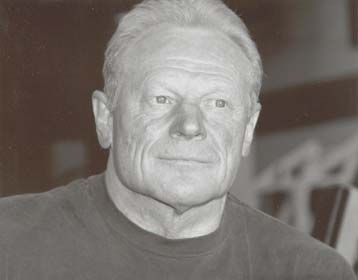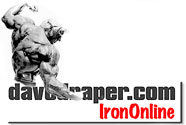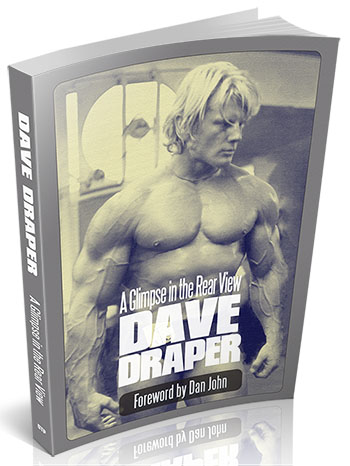Learn From My Mistakes

Howdy, Bomberoos.
The folks behind the popular website, Learn From My Mistakes, asked me to contribute material to their pages in the form of seven answers to seven questions; they’d supply the questions. “Good,” I said and here it is.
Probably not what the good folks were expecting. It’s a bit long-winded. They didn’t say, “smaller than a breadbox” or “briefly” or “in plain English.” You might consider printing it out to be deciphered, read, memorized, sung or set ablaze later…
Glide… dave draper
1. What do you feel is the single greatest trait (genetics, discipline, intensity, etc.) that led to your success in bodybuilding and why?
Nothing I possessed in the way of structure or body chemistry was outstanding. A six-foot frame with a large bone structure is certainly an advantage for which I am thankful, but they didn’t separate me from the crowd. Further, I didn’t have a burning ambition or dream to become a champion, a nuclear scientist or the President. I did have in my growing years, however, a simplistic approach on all projects undertaken… still do. What do I want? Is it sensible and worthwhile and how do I -- with common sense -- accomplish it? Once the questions are answered (guesses count), do it. Here you have a goal, focus and commitment.
It is during the simple process of achieving that one develops those grand habits and character qualities more valuable than blue chips or chocolate chips. Determination is one competent ally in gaining anything we have positioned before us. And determination spawns discipline, the thick leather reins that prompt and lead the untamable animal. The sum of determination and discipline is perseverance, the impenetrable armor of warriors.
So, keep your eye on that worthy goal; choose the logical (simple, most basic) way to go, and go. Go hard. It’s a struggle, yet without intensity, I have discovered, I don’t go far. Make room in your heart and mind to gather and store the determination, discipline and perseverance found in thick clumps along the way. Patience follows like a tired old mare; get used to her.
2. When training with weights, beginners often struggle to find the exercises and techniques that work best for their body types. What exercises and routines seemed to work best for you when you were just starting out? And what exercises did you try to avoid?
When I was starting out, I was very young and made up some dumb rules as I went along. Once I got my hands on some battered wall charts demonstrating the variety of exercises one could do, I chose the simplest (coincidentally like my own favorite inventions) and continued to train, grow in understanding and gain in muscle development. I was 12, what else could I do? What more could I expect?
Those biggies that kept me going, growing and interested were standing barbell curls, wrist curls, lying and standing triceps extensions or presses, bench presses, bentover barbell rows and stiffarm pullovers. I, like most kids, ignored the legs, as if they were miles away, below the beltline and out of sight.
Note: When I refer to “barbell,” I speak of a 16-inch bar with my limited selection of weights in the center and my tightfisted mitts squeezing what little was left of the bar’s short ends. The volume varied from 1 to 20 sets and reps, as I intuitively sorted things out and eventually added to my equipment list. Any routine worked as long as I stuck to it with regularity for 30 minutes. The word “technique” is not applicable to whatever it was I did during those grimacing, premature workouts. Wrestling, free-for-all and slugfest more appropriately describe the action taking place… a brawl or a battle-royale.
What I tried to avoid was dropping that congested bar on my head. Though I had no supervision early on, I was reasonably safe because I didn’t have very much poundage. The meanest wrong one can do when one is new to weight training is to use too much iron with too little know-how and too little physical conditioning.
Common disaster: “This is fun. I wonder, how much weight can I bench press?”
Tendons and muscle insertions that are unprepared for heavy resistance might tear or otherwise be damaged when subject to exuberant and heavy lifting: painful, frightening, disappointing and perhaps chronic.
Later, though, as I stepped into the VMCA and Vic Tanny’s of the late ‘50s, I zipped forward to dumbbells of assorted sizes, benches, racks and cables. Supersetting with the basic movements became my thing then and is to this day. Added to the list of original exercises I practiced as a kid are squats and deadlifts and shrugs and pulldowns and dumbbell presses… nothing fancy, just solid.
3. Many people who begin weight training are looking to build mass in their arms and chest. Can you talk about the importance of symmetry to a healthy looking body?
It’s important to understand the necessity of seeking balance in developing the body’s muscle structure. The body works as a system, mutually supporting and interdependent, and performs more healthfully and efficiently when developed as a functioning whole. Muscles grow faster, overall conditioning is achieved and no part of the body lags behind in formation as a result of neglect.
Imbalance in strength and structural development can cause chronic pain and degrees of disability as the years go by, i.e., a predominantly strong arm and chest development can lead to shoulder-rotation troubles; an abdominals muscles deficiency can lead to lower back troubles; weak hamstrings can present knee problems, etc. Does one want pain and limitations?
Getting huge at all cost is not unheard of among budding bodybuilders of all ages. Why not? They are promised extraordinary gains in short periods of time, if they use this formulation or that stack while following this champ’s routine. Stop and think. It’s smart to consider from the onset the eventual appearance of the body -- body esthetics, beauty, balance and appeal -- when enthusiastically embracing the bodybuilding field. A lopsided body can be a problem to correct, reflects your thinking and follows you wherever you go.
Simultaneously, however, I believe anyone who begins to train with weights should do whatever he or she feels like doing for whatever purpose. You can usually get away with a few months of floundering and butting your head against the wall without knocking your brains out or building 19-inch arms on a 150-pound frame. Gives the would-be champ time and space to search, invent, express, improvise and make a bunch of instructive mistakes of his very own. Freedom before margins.
4. Are there any nutritional secrets that beginners need to know to develop a powerful, healthy physique?
There are no secrets. Train hard, eat right and be happy!
Nutrition counts -- big time. What you eat is what you get. Eat regularly to fuel and restore the muscles throughout the day -- once every three to four hours. Up your intake of muscle-building protein (red meat, fish, poultry, dairy products, some nuts); exclude or greatly minimize simple sugars in your menu; eat lots of fresh vegetables and a fair share of fresh fruit (watch the sugar); get your fiber and eat whole-grain breads and grains that have not been overly processed. Don’t eat junk food, fast food and don’t overeat. Without drowning yourself, drink jugs of water. Add an excellent vitamin and mineral with antioxidants, along with a dose of essential fatty acids (EFAs) daily, and a protein powder to supplement meal planning if eating consistently is a problem -- or to help gain weight, or as a most important pre-workout and post-workout fortifier.
Simple, basic, honest. Takes devotion and habit building. It works, that’s all. It works.
5. Unfortunately, injuries are common in weight lifting. What mistakes can lead to injuries in the weight room? And how can beginners avoid them?
Injuries will visit without being invited. They come from eagerness, lack of body conditioning or preparedness, overload, not being warmed up, poor execution of an exercise, lack of concentration, undernourishment, inadequate pre-workout fueling, excessive overload, collective muscle tears over a period of time and/or lack of recuperation. There’s more I’m sure; the list goes on. The question requires a volume to answer even briefly.
I’ll highlight a few of the common mistakes in broken English:
~Too eager, too soon. Pushing, for example, a heavy bench press before the muscles and tendons have had a chance to adapt, thicken, lengthen and whatever else they need to do before squirming under the stress of an impossible weight. Imagine a new biceps and a young lower back under the enthusiastic swing of a cumbersome bar littered with cold iron. Snap, crackle, pop…
The sport is wonderful, tough, takes time and requires wisdom. Injuries impart wisdom. Slow down, think, be smart and save time… and a whole lot of misery.
~Similarly, it’s cold; you’re in a hurry, you press the dumbbells and the deltoid gurgles as a spike of pain is loudly hammered home.
Never hurry. Raise the body’s core temperature with sufficient aerobic work or, better yet, a vigorous ab workout, and hit the muscles and joints about to be blasted with a few light sets in preparation.
~You’re in the sport a long time and the bench lures you on and on. The bench press does that. I’ll bet you eventually get a chronic shoulder problem that threatens your sleep and the rest of your training if you persist to try to conquer the impenetrable steel fortress. The exercise is decent, though not the most efficacious muscle builder and shaper. It certainly is replaceable with safer dumbbell movements.
Beware. As a power lift it will lead to troubles. The shoulder mechanics do not provide for the extreme overload demanded by power training on the bench press. There is a protective bone-like tab within the joint to prevent overload and this becomes aggravated, and in time enlarged and inflamed causing real pain and limitation. Who among long-time weight trainers does not have a shoulder complaint?
~Improved nutrition invariably accompanies a solid interest in weight training. The basics of sound eating combined with sensible physical conditioning cause the system to more fully cooperate (as designed) and will add vitality, improve the health and flexibility of joints, increase bone density and improve resistance to injury. The muscles become an attractive armor against the perils of the hard work.
Feeding yourself healthfully is a primary factor in preventing injury on the gym floor.
6. When you are in the gym, what are some of the most common mistakes you see weight lifters making, and what can they do to correct the mistakes?
The answers to the question in regard to mistakes made that might cause injury would be poor form, too little focus and too much weight. The corrections I think are obvious. Learn and practice good form, concentrate totally on your training from start to finish (more practice) and lower the working weight. Be smart.
To answer the question broadly and assuming the goals are the development of body strength and health and not entertainment (which is certainly okay), the mistakes or shortcomings include lack of training involvement and too little intensity in exercise performance. Amplitude is missing. Desire and direction are major requirements if time spent on the gym floor is to be productive and fulfilling. They wane rapidly. This muscle-building and strength-building stuff works best when you work hard, want it bad, refer to your internal compass and have an honest sense of confidence in your pursuit and performance. You’ve got to blast it when you’re amid the metal, cable and racks.
Another thing: There’s more time and effort and wonder in seeking faster and easier ways to achieve muscle building goals than there is in the act of muscle building. Don’t waste your resources. Face it, muscle and power building is tough work, not magic.
7. Finally, what is the single biggest mistake you made in your bodybuilding career and what did you learn from it?
Aside from drinking too much alcohol 25 years ago and learning I’d have been better off not to drink at all, I reckon the mistakes I’ve made have only been incidents which contributed to the person I happen to be today, good or not so good.
I’ll spare you the philosophical baloney, but I prefer to think of muscle building as something I do as I go about my life, not who or what I’ve become -- not the career thing referred to as “bodybuilding.” I have always trained -- building muscle and might -- for function, focus, good fun and a hundred other valuable reasons.
That which others might call mistakes were just days of my life: No outstanding overload that cost me my lower back, knees or biceps, no crazy concoctions or dietary schemes that deteriorated my innards. I stepped on a few toes and acted like a jerk and hurt some folks along the way and would gladly for the good folks involved edit out those occasions. Yet, somehow, the world has continued to turn, for which I thank God.
Draper
And now where may I drop you?
May we answer any bodybuilding questions for you in our forum?
If you haven't yet read Dave's bodybuilding book, Brother Iron, Sister Steel, here's more information.
You may also enjoy our ongoing weight training and fitness article blog, which we update with new material several times each week.
Are you in the mood for reading an weight training book excerpt?
Can I tell you about whey protein powders?
Could you use a new 8-week workout routine or a bodypart workout program? Need to learn how to squat or how to deadlift?
Or select a link to the right to discover our most popular pages that are sure to answer all your training questions.

